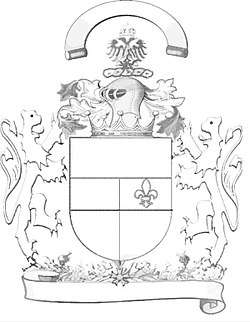Mantling

| Part of a series on |
| Heraldic achievement |
|---|
| Conventional elements of coats of arms |
|
|
In heraldry, mantling or lambrequin is drapery tied to the helmet above the shield. It forms a backdrop for the shield. In paper heraldry it is a depiction of the protective cloth covering (often of linen[1]) worn by knights from their helmets to stave off the elements, and, secondarily, to decrease the effects of sword-blows against the helmet in battle, from which it is usually shown tattered or cut to shreds; less often it is shown as an intact drape, principally in those cases where clergy use a helmet and mantling (to symbolise that, despite the perhaps contradictory presence of the helmet, they have not been involved in combat), although this is usually the artist's discretion and done for decorative rather than symbolic reasons.
Generally, mantling is blazoned mantled x, doubled [lined] y; the cloth has two sides, one of a heraldic colour (the five principal colours being red, blue, green, black, or purple—there are other very rare colours as well) and the other of a heraldic metal (white or yellow). (See tincture (heraldry) for more on these tinctures.) The mantling is usually in the main colours of the shield, or else in the livery colours that symbolize the entity bearing the arms, though there are exceptions, with occasional tinctures differing from these, or occasional examples in which the outside of the mantling is per pale of two colours[2] or both the inside and outside are per pale,[3] and even rarer examples of other divisions,[4] and there is a perhaps unique example in which the lining of the mantling is per pale of the two metals[5] or of the entire mantling being of a single tincture.[6] The mantling of the Black Loyalist Heritage Society[7] is a unique example in which the mantling is of two furs (ermines, lined ermine). The Coat of Arms of Canada is mantled white and red, or argent doubled gules; furthermore, the current standard rendering of the Canadian arms has mantling in the shape of maple leaves. The arms of sovereigns are a common exception. The arms of the United Kingdom and those of Emperor Akihito of Japan are both or, lined ermine,[8] such a mantling often being held to be limited to sovereigns.
In the early days of the development of the crest, before the torse (wreath), crest coronets and chapeaux were developed, the crest often "continued into the mantling" if this was feasible (the clothes worn by a demi- human figure, or the fur of the animal, for instance, allowing or encouraging this). It still holds true frequently in Germany.
There are rare examples where the mantling is blazoned to complement the armiger's coat of arms, mimicking the ordinaries and charges on the escutcheon. When charges occur, they are usually displayed as a semy.[9]
See also
References
| Wikimedia Commons has media related to Mantling. |
- ↑ Encyclopædia Britannica - Mantling
- ↑ "Archived copy". Archived from the original on 2007-09-28. Retrieved 2007-03-26.
- ↑ Shares, National Infocommunications Service Company Limited by. "National and historical symbols of Hungary". www.nemzetijelkepek.hu. Retrieved 15 April 2018.
- ↑ "Sitio oficial de Sutamarchan en Boyaca, Colombia". Archived from the original on 2012-07-14. Retrieved 2007-10-21.
- ↑ "College of Arms: The Arms and Badge of Professor S. W. Haines". Retrieved 2008-01-14.
- ↑ "Russian Heraldry as It is /". Retrieved 2007-11-28.
- ↑ "The Public Register of Arms, Flags and Badges of Canada: Arms of the Black Loyalist Heritage Society".
- ↑ Michon, Gerard. "Coat-of-arms of Heisi Tenno (Emperor Akihito) as Knight of the Garter". Numericana. Retrieved 15 April 2018.
- ↑ "Archived copy". Archived from the original on 2007-09-28. Retrieved 2007-03-26.
